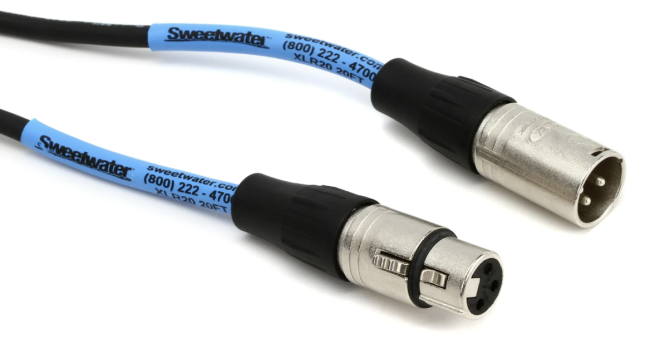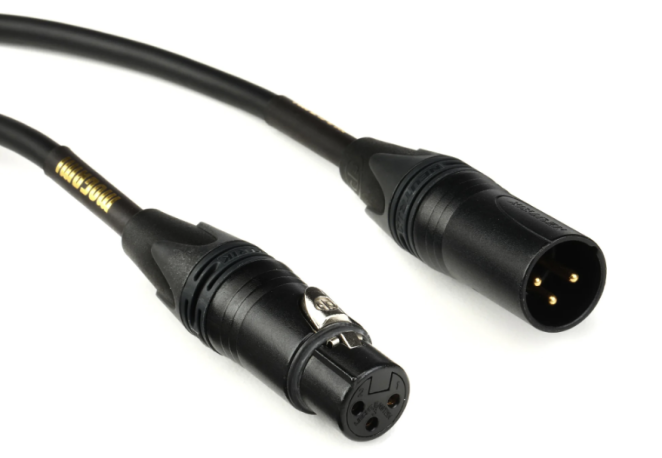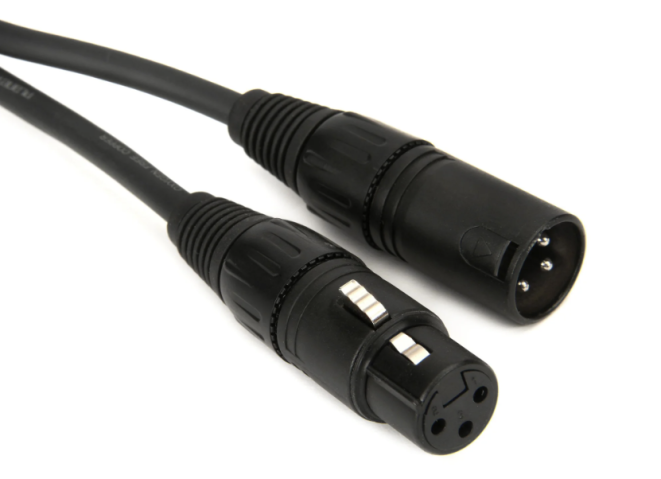The right XLR cable is the key to a balanced audio connection. They're an excellent choice when looking to connect microphones, instruments, amplifiers, and more for your next studio recording or live gig. In this article, I'm covering the top 4 best XLR cables of 2024 and highlighting why each of them earned a spot on our list.
I also threw in a buyer's guide at the end so you know what features to look out for when you're shopping for a new XLR cable. Our #1 pick for the best overall XLR cable is the Mogami CorePlus Microphone Cable for its affordable price, amazing build quality, and ultra high-density shielding ward.
Keep reading to see if the Mogami CorePlus is the best XLR cable for your next live show or if the D'Addario PW-CMIC-50 is more your speed.
Quick Summary of the 4 Best XLR Cables of 2024
- Mogami CorePlus Microphone Cable (Best Overall XLR Cables)
- Pro Co EXM-20 (Best XLR Cables at Multiple Lengths)
- Mogami Gold Studio Microphone Cable (Best Premium XLR Cables)
- D'Addario PW-CMIC-50 Classic Series Microphone Cable (Best 50' XLR Cables)
Best XLR Cables Reviewed
Best Overall
The Mogami CorePlus Microphone cable is designed to withstand the hardest of tour schedules. Check out this XLR cable if you need a mic cable for your next string of road dates.
SPECS:
- Length: 5', 10', 15, 25', and 50'
- Gauge: 26
- Shielding: Ultra High-Density Spiral Shielding
What Could Be Improved
- Could come with gold-plated connections
The Mogami CorePlus Microphone Cable is an excellent cable for the beginning artist and the experienced road dog alike. This XLR cable is one of the most durable on our list today, preventing both audio interference and rips and tears through its expert construction.
It comes in 5 different lengths so you can find the right cord for your setup. The Mogami CorePlus also comes with Neutrik REAN nickel connectors for a solid connection. At less than $50 for a 15' foot microphone cable, there aren't many cables around that offer the same quality for an equally affordable price.
Mogami is well known for its reliable audio equipment. They use ultra-high density spiral shielding to fight against unwanted interference while a conductive PVC sub shield defends against electrostatic as well.
If you're looking for some new gear for your setup, an XLR cable that's the gold standard of its class, look no further than the Mogami CorePlus Microphone Cable. It does everything you could want from an XLR cable very well and at an affordable price.
Best at Multiple Lengths
The Pro Co EXM-20 is one of the most versatile XLR cables on our list today. It's a great cable that comes in 8 lengths, giving you more than enough options when shopping.
SPECS:
- Length: 10', 15', 20', 25', 30', 50', 75', and 100'
- Gauge: 24 AWG
- Shielding: Spiral Shielding
What Could Be Improved
- Could have nickel-tipped connectors
The Pro Co EXM-20 is an XLR cable built for the musician who wants the longest cable possible. Or a short cable, as the EXM comes in 8 different lengths ranging from 10' to 100'. The Pro Co EXM-20 is a great general-purpose microphone cable that will get the job done with great sound quality.
When it comes to XLR cables, you want reliable shielding and wires to transmit your signals. Pro Co has combated this issue by including oxygen-free wire and plenty of spiral shielding to enhance signal quality and reduce noise interference no matter where you bring your cable.
Pro Co has also included industry-standard Neutrik plugs with their EXM series of cables. These metal connectors are high quality and built to last. Speaking of built-to-last, Pro Co has included an impressive lifetime warranty with their EXM cables. If there are any manufacturing problems with your cables, you can send them right back at no cost and get a new cable sent your way.
The Pro Co EXM-20 is a powerful XLR cable that can do it all with quality. It's great for home studios and road dates alike. Check out this connector if you need an XLR cable for touring long distances or even for good old-fashioned studio use.
Best Premium XLR Cable
SPECS:
- Length: 2', 3', 6', 10', 15', 25', 50', and 100'
- Gauge: 24 AWG
- Shielding: Spiral
What Could Be Improved
- Other than a lower price tag, not much
If budget isn't an issue, we'd like to introduce you to the Mogami Gold Studio Microphone Cables. These cables come with some of the highest connector quality of any on our list. They also come at the same length as many of the other choices, making them a great upgrade on cables you may already have.
The Mogami Gold Studio comes at different cable lengths, blocks out RF interference, and is excellent at handling noise. This is the perfect cable for an audiophile looking to upgrade their current setup. At less than $100 for 25' of cable, you're getting a great value on phenomenal XLR plugs.
Mogami's cables have some of the best audio clarity on the planet. These cables are great for live performances, studio use, and just about anything else. They excel as transparent, "lossless" cables that help you get the playback you're looking for.
The Mogami Gold Studio Microphone Cable is the best XLR cable on this list if you don't have a budget. They come with some of the best wires and XLR connectors on this list and come with the gold XLR plugs you need for a killer sound.
Best 50' XLR Cable
SPECS:
- Length: 10', 25', and 50'
- Gauge: 24 AWG
- Shielding: Spiral
What Could Be Improved
- Could have gold instead of copper conductors
When you need a serious amount of cable, the D'Addario PW-CMIC-50 is here to help. It comes in three different cable lengths but we're going to be focusing on the 50' length for this entry. We chose that specific length because of the cable's oxygen-free copper conductors, 95% shielding, and powerful audio signal.
The D'Addario PW-CMIC-50 comes with nickel-plated plugs and dense spiral shielding for balanced audio. They're excellent for both microphones and powered speakers.
We like these cables at 50' because they have molded strain relief for even more durability. When you're traveling or doing road gigs, the last thing you want to worry about is the quality of your equipment. D'Addario pins this issue down through all of the features we listed above and more, allowing you to rest assured that your next gig will sound as good as your last.
We like the D'Addario PW-CMIC-50 for its excellent, durable build quality and its affinity with speakers and microphones. It's the perfect cable for enduring road gigs and would work very well sitting in a studio as well. Check out the latest from D'Addario if you need 50' of quality XLR cable.
Best XLR Cables Buyer's Guide
Before you buy a new pair of XLR cables, there are a couple of key factors you should keep in mind. The best XLR cable for you is the perfect length, has great shielding, is plenty flexible, has the cable gauge you're looking for, and is made out of reliable materials.
Length
When you're looking to buy any type of cable, length is hugely important. If you can't reach your audio equipment, what's the point? The right microphone cables come in different sizes. You can get an XLR cable with a 5' length or get the same one 45' longer.
While it's better to get a cable with a little more room than less, it's always a good idea to avoid excess slack. Having too much slack can lead to excessive signal degradation and clutter. Choose the most efficient size for your setup.
Shielding
Shielding can help protect your XLR cable for years to come. Understanding the different types will help you pick the right shielding for your specific needs. Some of the most popular forms of shielding included braided shielding and foil shielding.
Braided shielding provides flexibility and durability while foil shielding provides excellent protection against electromagnetic interference. If you're working in a studio with a lot of electronic devices, you might need foil shielding more than braided shielding.
Flexibility
While your cables probably won't move much in a studio setting, they must be flexible. Flexible cables typically use materials like rubber or PVC for the jacket. Look for cables with a design that allows for easy bending and twisting without kinking or damage.
The more flexible the cable, the easier it is to handle during setup and teardown, reducing the risk of tangling or accidental damage.
Cable Gauge
An XLR cable's gauge is another very important factor that can affect your sound. The gauge of a cable refers to the thickness of the conductors inside the cable. Thicker cables (cables with lower gauge numbers) have lower resistance and are better suited for longer cable runs.
Thinner cables, on the other hand, might be better for shorter distances or lower power applications. For professional studio use, thicker cables are almost always recommended to maintain signal integrity.
Build Quality
Build quality is important in any product you buy and that doesn't change with an XLR cable. When shopping, look for connectors made of durable materials like metal for longevity and reliable connectivity. The most common connectors you can find are nickel and gold-plated connectors.
Make sure your connectors have plenty of strain relief as well. Many XLR cables have strain relief in the form of rubber boots built into the connector housing.
Frequently Asked Questions (FAQs)
What length of XLR cable do I need?
The length of your XLR cable is one of the most important parts of your purchase. You don't want a cable that's too short because it won't reach and you may as well have not bought it in the first place. While cables with extra length may seem useful, they can add to noise interference if they're too long.
Measure the distance between your audio devices before you make your purchase. Most cables come in multiple lengths in sets of 5', giving you plenty of options in terms of connections.
What's the difference between balanced and unbalanced XLR cables?
Balanced cables have three conductors, (positive, negative, and ground) and are much less susceptible to interference compared to unbalanced cables. They're most often used in professional audio settings to maintain an audio signal over longer distances.
Unbalanced cables make work better for you if you're using a cable that is less than 10' long or if you're in a smaller studio setting.
Should I choose XLR cables with gold-plated connectors?
Gold-plated connectors offer better conductivity and corrosion resistance compared to standard connectors without gold. They offer a performance improvement, but it's not great enough for the average audio enthusiast to break the bank.
If you're looking for the highest quality connections available though, we'd point you in the direction of gold-plated connectors.
What's the difference between premium and budget XLR cables?
XLR cables are available at a range of different prices. If you're willing to spend a little more on some of the premium XLR options, you will find higher-quality building materials, better construction, and even more efficient shielding compared to budget cables.
The higher price tag might be a drawback, but the reliability, durability, and improved performance they offer are second to none when you need the best recording possible in a professional audio environment.
Should I buy XLR cables individually or in packs?
XLR cables are some of the only audio products you can buy both individually and in packs. If you need a couple of cables to set up, buying them in packs could save you some money. If you only need a single cable or are looking at cables of different lengths, it could be a better idea to buy your cables individually.
Conclusion
Buying the right XLR cable can make all the difference in your next performance. If you want to find the perfect cable, pay attention to its length, build quality, cable gauge, flexibility, and shielding.
My pick for the best overall XLR cable is the Mogami CorePlus. It's an excellent cable with strong Neutrik connectors, high-quality wires, and a build quality ready for heavy use.
But if you have a little more room in your budget and want to hear the best Mogami has to offer, give their Gold Studio Microphone Cable a try.




